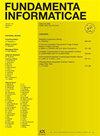布尔网络实现转换系统技术的复杂性
IF 0.4
4区 计算机科学
Q4 COMPUTER SCIENCE, SOFTWARE ENGINEERING
引用次数: 0
摘要
让我们考虑一类(Petri)网。相应的综合问题包括决定给定的标记转换系统(TS) a是否可以由该类的净N实现。在负面决定的情况下,可以通过应用各种修改技术将a转换为可实现的TS B,例如重新标记以前具有相同标签的边,抑制边/状态/事件等。然而,限制此类修改的数量以接近原始问题或优化技术可能是有用的。在本文中,我们证明了如果所考虑的类对应于所谓的触发器网络或某些触发器网络导数,则大多数相应的问题是np完全的。本文章由计算机程序翻译,如有差异,请以英文原文为准。
On the Complexity of Techniques That Make Transition Systems Implementable by Boolean Nets
Let us consider some class of (Petri) nets. The corresponding Synthesis problem consists in deciding whether a given labeled transition system (TS) A can be implemented by a net N of that class. In case of a negative decision, it may be possible to convert A into an implementable TS B by applying various modification techniques, like relabeling edges that previously had the same label, suppressing edges/states/events, etc. It may however be useful to limit the number of such modifications to stay close to the original problem, or optimize the technique. In this paper, we show that most of the corresponding problems are NP-complete if the considered class corresponds to so-called flip-flop nets or some flip-flop net derivatives.
求助全文
通过发布文献求助,成功后即可免费获取论文全文。
去求助
来源期刊

Fundamenta Informaticae
工程技术-计算机:软件工程
CiteScore
2.00
自引率
0.00%
发文量
61
审稿时长
9.8 months
期刊介绍:
Fundamenta Informaticae is an international journal publishing original research results in all areas of theoretical computer science. Papers are encouraged contributing:
solutions by mathematical methods of problems emerging in computer science
solutions of mathematical problems inspired by computer science.
Topics of interest include (but are not restricted to):
theory of computing,
complexity theory,
algorithms and data structures,
computational aspects of combinatorics and graph theory,
programming language theory,
theoretical aspects of programming languages,
computer-aided verification,
computer science logic,
database theory,
logic programming,
automated deduction,
formal languages and automata theory,
concurrency and distributed computing,
cryptography and security,
theoretical issues in artificial intelligence,
machine learning,
pattern recognition,
algorithmic game theory,
bioinformatics and computational biology,
quantum computing,
probabilistic methods,
algebraic and categorical methods.
 求助内容:
求助内容: 应助结果提醒方式:
应助结果提醒方式:


